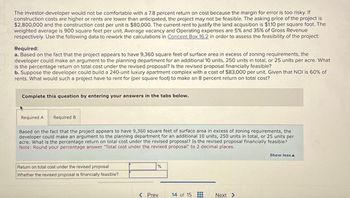
Essentials Of Investments
11th Edition
ISBN: 9781260013924
Author: Bodie, Zvi, Kane, Alex, MARCUS, Alan J.
Publisher: Mcgraw-hill Education,
expand_more
expand_more
format_list_bulleted
Question
None

Transcribed Image Text:The investor-developer would not be comfortable with a 7.8 percent return on cost because the margin for error is too risky. If
construction costs are higher or rents are lower than anticipated, the project may not be feasible. The asking price of the project is
$2,800,000 and the construction cost per unit is $80,000. The current rent to justify the land acqusition is $1.10 per square foot. The
weighted average is 900 square feet per unit. Average vacancy and Operating expenses are 5% and 35% of Gross Revenue
respectively. Use the following data to rework the calculations in Concept Box 16.2 in order to assess the feasibility of the project:
Required:
a. Based on the fact that the project appears to have 9,360 square feet of surface area in excess of zoning requirements, the
developer could make an argument to the planning department for an additional 10 units, 250 units in total, or 25 units per acre. What
is the percentage return on total cost under the revised proposal? Is the revised proposal financially feasible?
b. Suppose the developer could build a 240-unit luxury apartment complex with a cost of $83,000 per unit. Given that NOI is 60% of
rents. What would such a project have to rent for (per square foot) to make an 8 percent return on total cost?
Complete this question by entering your answers in the tabs below.
Required A
Required B
Based on the fact that the project appears to have 9,360 square feet of surface area in excess of zoning requirements, the
developer could make an argument to the planning department for an additional 10 units, 250 units in total, or 25 units per
acre. What is the percentage return on total cost under the revised proposal? Is the revised proposal financially feasible?
Note: Round your percentage answer "Total cost under the revised proposal" to 2 decimal places.
Return on total cost under the revised proposal
Whether the revised proposal is financially feasible?
%
< Prev
14 of 15
Next >
Show less A
Expert Solution
This question has been solved!
Explore an expertly crafted, step-by-step solution for a thorough understanding of key concepts.
Step by stepSolved in 2 steps

Knowledge Booster
Similar questions
arrow_back_ios
SEE MORE QUESTIONS
arrow_forward_ios
Recommended textbooks for you
 Essentials Of InvestmentsFinanceISBN:9781260013924Author:Bodie, Zvi, Kane, Alex, MARCUS, Alan J.Publisher:Mcgraw-hill Education,
Essentials Of InvestmentsFinanceISBN:9781260013924Author:Bodie, Zvi, Kane, Alex, MARCUS, Alan J.Publisher:Mcgraw-hill Education,

 Foundations Of FinanceFinanceISBN:9780134897264Author:KEOWN, Arthur J., Martin, John D., PETTY, J. WilliamPublisher:Pearson,
Foundations Of FinanceFinanceISBN:9780134897264Author:KEOWN, Arthur J., Martin, John D., PETTY, J. WilliamPublisher:Pearson, Fundamentals of Financial Management (MindTap Cou...FinanceISBN:9781337395250Author:Eugene F. Brigham, Joel F. HoustonPublisher:Cengage Learning
Fundamentals of Financial Management (MindTap Cou...FinanceISBN:9781337395250Author:Eugene F. Brigham, Joel F. HoustonPublisher:Cengage Learning Corporate Finance (The Mcgraw-hill/Irwin Series i...FinanceISBN:9780077861759Author:Stephen A. Ross Franco Modigliani Professor of Financial Economics Professor, Randolph W Westerfield Robert R. Dockson Deans Chair in Bus. Admin., Jeffrey Jaffe, Bradford D Jordan ProfessorPublisher:McGraw-Hill Education
Corporate Finance (The Mcgraw-hill/Irwin Series i...FinanceISBN:9780077861759Author:Stephen A. Ross Franco Modigliani Professor of Financial Economics Professor, Randolph W Westerfield Robert R. Dockson Deans Chair in Bus. Admin., Jeffrey Jaffe, Bradford D Jordan ProfessorPublisher:McGraw-Hill Education

Essentials Of Investments
Finance
ISBN:9781260013924
Author:Bodie, Zvi, Kane, Alex, MARCUS, Alan J.
Publisher:Mcgraw-hill Education,



Foundations Of Finance
Finance
ISBN:9780134897264
Author:KEOWN, Arthur J., Martin, John D., PETTY, J. William
Publisher:Pearson,

Fundamentals of Financial Management (MindTap Cou...
Finance
ISBN:9781337395250
Author:Eugene F. Brigham, Joel F. Houston
Publisher:Cengage Learning

Corporate Finance (The Mcgraw-hill/Irwin Series i...
Finance
ISBN:9780077861759
Author:Stephen A. Ross Franco Modigliani Professor of Financial Economics Professor, Randolph W Westerfield Robert R. Dockson Deans Chair in Bus. Admin., Jeffrey Jaffe, Bradford D Jordan Professor
Publisher:McGraw-Hill Education